Overview
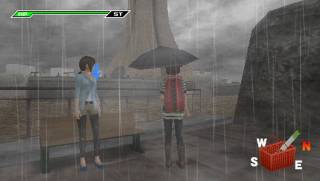
Zettai Zetsumei Toshi 3: Kowareyuku Machi to Kanojo no Uta is the third entry in the Zettai Zetsumei Toshi/Disaster Report franchise, developed by Irem for the PSP and released exclusively in Japanese. Taking place on a newly built man-made island in Japan, the game tasks players with surviving in a fight against nature as it sets out to ravage the island by way of such things as earthquake tremors and flooding, ideally making it out and back to the Japanese mainland in one piece. As the sequel to Raw Danger for the PS2, ZZT3 follows many of the gameplay and narrative conventions outlined in the first two games, which include disaster survival-centric gameplay mechanics that are devoid of violence and a realistic storyline that is partly designed to be educational. Several new additions are present that enhance the core formula, however, with the most notable ones being a stress meter that influences the protagonist's health, cooperative multiplayer missions, and recurring safety tip messages that teach players how to survive various scenarios that they encounter in the game in a real world context. Although not originally designed to be the final game in the series, the fourth game, Zettai Zetsumei Toshi 4: Summer Memories for the PS3 was cancelled in the wake of the Tohoku Earthquake in March 2011, officially declared to be due to difficulties optimizing the game's code in the final stretches of development.
Gameplay
Zettai Zetsumei Toshi 3 shares many gameplay mechanics with the previous two entries in the series. The game sports two playable protagonists, one male and one female, who share largely the same storyline and gameplay mechanics, but with a few distinctions in areas such as stats to differentiate them as characters. As with those games, ZZT3 emphasizes purely defensive survival tactics as the environment around the player crumbles around them at the hands of nature. Earthquake tremors, for instance, require that the player brace the ground until the vibrations subsist and it's safe to walk around again, while fires compel them to crawl in order to minimize smoke inhalation. Item gathering and exploration are also of the utmost importance; making do and improvising with the material remnants of society is key to maintaining the protagonist's health and safely navigating dangerous indoor and outdoor environments. Inventory management and item crafting also return in the game as additional pieces to the survival puzzle. Several other major characters additionally accompany the protagonist at various points throughout the story, providing moral support and assistance in overcoming various obstacles when necessary.
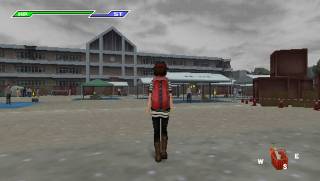
The main new wrinkle to ZZT3's gameplay comes in the form of a stress meter. As the player wanders around through the environment and deals with the natural disaster as it unfolds, their character's stress will steadily increase to differing extents. Although stress is initially a distinctly separate metric from health, undergoing too much stress can cut into the player's vitality meter, resulting in the maximum amount of health slowly decreasing the longer the character is exposed to danger and stress-inducing sights such as corpses. Nevertheless, stress can be cured by sitting on benches at predetermined points in the game that also serve as save points, resulting in the vitality meter also reverting back to maximum.
Like Disaster Report and Raw Danger, ZZT3's storyline is heavily influenced by player choice. While many of these choices come in the form of dialog trees, they also sometimes occur over the course of normal gameplay, forcing the player to choose between conflicting priorities with little time to think things over. Unlike many other games that manifest player choice through dialog choices, however, ZZT3 is different in that there are usually myriad conversation options that enable the player to fine tune their reactions and antics. As with the rest of the series, although these choices can influence which ending is attained and how supporting party members interact with the protagonist, they are not otherwise explicitly judged in terms of a "good versus evil" paradigm; the game merely notes which choices have been flagged internally and allows things to proceed in an organic manner. Additionally, unique to ZZT3 is the fact that these choices also subtly influence the sort of personality the protagonist comes to adopt, which in turn influences how quickly and to what extent their stress meter fills up over the course of gameplay. Beyond that, the choice in gender for the protagonist can further influence the wording and implication of certain dialog choices; the female protagonist is particularly notable in that the player is allowed to role-play her as a lesbian, should they desire to do so.
Cast
Main Characters
Rina Makimura/Naoki Kousaka
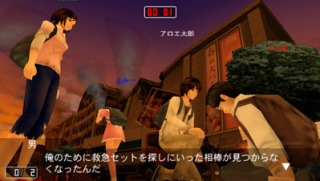
Rina Makimura and Naoki Kousaka are the selectable female and male protagonists of the game, respectively represented by their default outfits of the pink sport shirt and beige jacket. Both of them are 18 year-old Japanese kids who come to the island to start their college career before getting caught up in the disaster on the day of their arrival. Dialog choices aside, they largely play the same, save for the fact that Rina is less susceptible to stress at the cost of her maximum health and vice versa for Naoki.
Saki Honjou
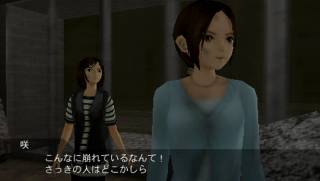
Saki Honjou is a fellow survivor and constant companion to Rina/Naoki that the player rescues under some debris early on in the game. A former singer who turned her attention to nursing, Saki is a level-headed, but caring person who serves as a mentor to help the protagonist make it off the island alive. She can occasionally still be found nostalgically humming and singing, something that can be used to stave off stress during gameplay at key points. The game's ending is influenced in part by how the player chooses to speak and act around her.
Ayami Hazuki
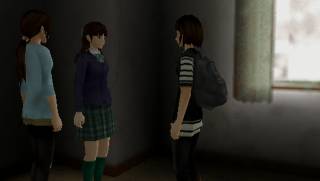
Ayami Hazuki is another survivor and serves as the other main companion for the protagonist during most of the game. Found trapped inside a collapsed hotel when the game first introduces her, she's a skittish person who has deep connections to the island's construction and administration. Like with Saki, the contents of ZZT3's endings are determined in part by the relationship the player strikes with Ayami.
Supporting Characters
Keisuke Hikawa
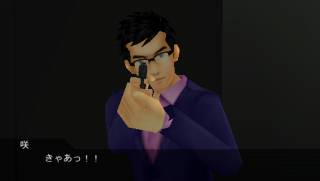
Keisuke is a police detective with an agenda of his own, opting to still conduct his work in the midst of all of the wreckage. Initially perceived to be an antagonist due to his presence at the scene of a murder early in the game's plot, his motives become increasingly ambiguous as it becomes clear he has longstanding relationships with other members of the cast, particularly Ayami.
Youichi Ishizawa
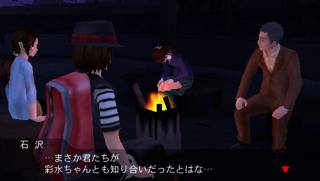
Youichi is an older man who is hounded by Keisuke as he continues to pursue his objectives. Although Youichi is someone Ayami has known for a long time and deeply respects, his reputation as a geologist was sullied after he was hired to do the initial surveying that would determine the viability of the island's construction. He also had a daughter who worked for the construction firm that worked on the island, but who has since died, believed to have killed herself after revelations pointed to her involvement in an embezzlement scandal.
Ryouko Honda

A recurring character from Raw Danger, Ryouko is a journalist investigating the island and the circumstances surrounding its construction. Keen on uncovering corporate secrets and cover-ups, it becomes apparent as the protagonist talks with her throughout the game that the reasons behind the disaster are at least in part due to human error.
Natsumi Higa
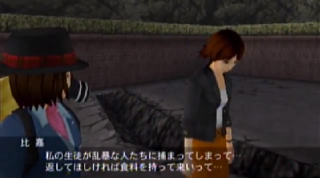
Another recurring character who also appears in both Disaster Report and Raw Danger, Natsumi is a teacher a local school when the initial earthquake hits. As has become a trope in the rest of the series, the player first discovers her lying face down in the ground, trapped in a dire situation she can't get out of without outside help. She plays a critical role in a subplot in which the player is forced to scavenge for food for a refugee camp that is slowly starving.
Disaster Survival Education
At various junctures through Zettai Zetsumei Toshi 3, the game will pause momentarily to notify the player that they've unlocked a relevant tip that can be viewed at their leisure about how to survive the current situation that they're facing in real-world situations. Written with assistance and data provided from major Japanese disaster organizations, these tips run the gamut from how to deal with things such as earthquake tremors, floods, and fire whirls to navigation methodologies to even cell phone usage and maintaining social order, among others. Spanning dozens of tips that appear throughout the course of the game, they also regularly serve as gameplay hints, since environmental puzzles are designed to be solved in a realistic manner.
Music
At certain points in the game, Saki's musical talents play a critical role in advancing the plot, an element which is referenced in the game's subtitle, Kowareyuku Machi to Kanojo no Uta, literally translated as "The Crumbling City and Her Song." To that end, one of the few pieces of non-gameplay-related extra content in Zettai Zetsumei Toshi comes in the form of Saki's music, which is available with both Japanese and English vocals. Unlocking all of the songs and their different versions requires playing the game to completion twice, once as Rina and another time as Naoki. Although the English and Japanese vocals for each song are unlocked separately, an options setting that can be changed at any time during gameplay otherwise determines which one is actually heard during normal gameplay.
Legacy
As it was previously stated, Zettai Zetsumei Toshi 3 was not originally planned by Irem to be the final installment of the series. However, after the Tohoku Earthquake that struck Japan in March 2011, executives at the company deemed the political environment in Japan to be too delicate to continue releasing disaster-themed games, especially since certain events in the Tohoku Earthquake mirrored plot devices that were first portrayed in the ZZT games. That stance coupled with development difficulties related to the perpetually delayed fourth installment for the PS3 led Irem to cease production of all games aside from its pachislot simulators. This resulted in all ZZT installments no longer receiving reprints, with the digital downloadable version of ZZT3 and corresponding demo also being taken off of the PSN Store. The official web sites for every games in the series were also rendered inaccessible.
In the months following the earthquake, Irem received hundreds of letters of support from the Japanese populace requesting that production of the series continue, as the educational aspects of the series had, in some instances, saved people's lives during the Tohoku Earthquake. Such efforts were to no avail, though. Having no desire to remain involved with a pachislot-only game development company, many members of the team behind the ZZT series, including creator and producer Kazuma Kujo, ultimately splintered off from Irem to form Granzella with the intention of eventually releasing another disaster survival game, feeling a social responsibility to continue the legacy. Granzella remains a prominent developer of PlayStation Home content both within and outside Japan.

 PlayStation Portable
PlayStation Portable.png) PlayStation Network (PSP)
PlayStation Network (PSP)





























